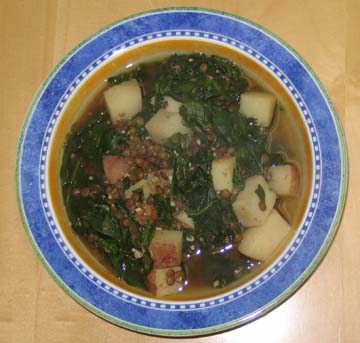It was a busy week, food and otherwise. Our CSA is winding down for the year, and our haul for the week was decidedly autumnal. We got one bunch of leeks, four sugar pumpkins, six pounds of potatoes, and 36 McIntosh apples (about 12 pounds). Given that the leeks were the only green item, I was very glad that we had bought greens at the weekend farmers market.
The four pumpkins would have brought our tally to 7, but the one from week 20 rotted and had to get composted. What does one do with so much pumpkin? These average 3 cups of mashed flesh, which is 3 times as much, in any one pumpkin, as a typical pumpkin-anything recipe calls for. Even a pumpkin pie uses only 2 cups, and blends it with all sorts of bad-for-you stuff like condensed (or is it evaporated?) milk and eggs and sugar.
We increased our daily apple intake from one to two. We’re drying apples (6 in a typical dehydrator batch). We made an apple crisp with 6 Cortland apples. Apples are pushing other foods aside in our refrigerator. We’ve made the occasional snack or dessert of apple slices fried in local butter. Yum! We really need to make applesauce with them–10 pounds of apples fit in our stock pot–but we haven’t yet figured out where we’d put a chest freezer, so we haven’t bought one yet. Our freezer is pleasantly full of vegetables from the summer, but, well, it’s full.
We started to take things out of the freezer. We used a 2-cup block of frozen tomatoes (stewed in their own juice) to make curried chickpeas and collard greens, more or less following the Joy of Cooking recipe. We had bought the collard greens at the weekend farmers market.
My husband went, as usual, to the mid-week farmers market, to get what our CSA didn’t provide. He brought home 10 pears because they are fruit that is not apples. He brought home a bunch of bok choy, a bunch of spinach, and a bunch of broccoli, because they were green.
The bok choy and half of the broccoli went into a stir-fry with some of the mushrooms from last week, and the Jamaica Plain tofu. (For any non-locals reading this, Jamaica Plain is a neighborhood of Boston.) Chicken-of-the-woods mushrooms tend to be tough, so my husband cut them up and then simmered them while the rice boiled. By the time he added them to the stir-fry they were quite tender and delicious. We had expected to be able to save the mushroom broth for other cooking, but there was some sort of insect on the mushroom that we didn’t find before cooking, and insect broth just isn’t appealing to us.
We shared the joy of eating local at a couple of potlucks. One of them we were guests at, and brought potato salad with dill and scallions. It was a good way to use up scallions. The potatoes and dill were from the weekend farmers market, bought in anticipation of the potluck. The scallions were from our CSA in week 18. A lot of ends and outer layers had to be discarded, but there was plenty left for the salad.
The other potluck was one we hosted. We invited guests to participate in the Eat Local Challenge by including at least one local ingredient in whatever they brought. Some of them had fun with it: one couple brought a squash soup made with butternut squash, apples, and onions from the Davis Square farmers market. Another couple brought a salad of lettuce, spinach, and cherry tomatoes from the Copley Square farmers market, with basil from their own garden.
As hosts, we wanted to make sure there was enough food. We made an enchilada casserole and an apple crisp (using 6 Cortland apples, as mentioned above), and provided local apple cider and local wine. The wine we found was a chardonnay from Westport Rivers winery in Westport, MA, about 60 miles away. The enchilada casserole had a base layer of gorditas (thick tortillas) from the Cinco de Mayo tortilla factory in Chelsea, MA. That was covered with a thick layer of mashed black beans mixed with spices and shredded Vermont cheddar cheese. (The black beans were from dried, and we reserved some of the simmering liquid to mash them.) That was covered with another layer of gordita tortillas. Then a generous sprinkling of more cheddar cheese, and the whole thing was covered with a batch of tomatillo salsa. The salsa was made with CSA tomatillos and cilantro, and scotch bonnet peppers we’d frozen from the farmers market last summer. It’s very tasty and very easy to serve to a crowd, or to dish out servings at home over a few days. We’ll definitely make it again!
I’ll leave you with this: Hot milk sweetened and flavored with maple syrup is a real local treat. Who needs hot chocolate, anyway? (Well, me, but not this month.)
